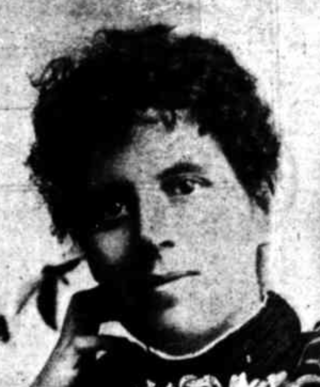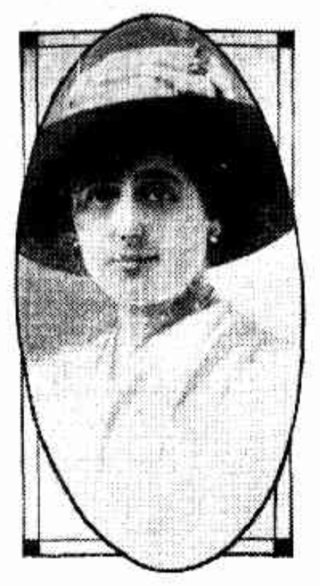
Isabella Kate Jobson RRC (1878 - 6 July 1943) was an Australian nurse who served in World War I. [1]

Isabella Kate Jobson RRC (1878 - 6 July 1943) was an Australian nurse who served in World War I. [1]
Jobson was born at Clunes, Victoria in 1878 to Christopher Jobson, a merchant from Northumberland, England, and his second wife Elizabeth Cameron, née McColl, from Scotland. [2] She was educated at South Melbourne College and, in 1893, passed the University of Melbourne's matriculation examinations in algebra, geometry, arithmetic and geography, and gained honours in French. [3] [4] She trained as a nurse at the Alfred Hospital in Melbourne, where she met and became friends with Leah Rosenthal; in late 1910 the two women took over the running of Windarra Private Hospital in Toorak. They left the hospital, and Australia, together in December 1915 and travelled to England to serve in World War I. [5]
In England, they joined Queen Alexandra's Royal Army Nursing Corps (QAIMNS) and in February 1916 they were assigned to Baythorpe Military Hospital in Nottingham. [6] In April of that year they embarked for duty in France. Jobson was assigned to stationary hospitals and casualty clearing stations and served until January 1919, when she resigned her appointment. She returned to Melbourne in May 1919 and she and Rosenthal again bought a private hospital to run together. The hospital had previously been named St Luke’s Private Hospital, however Jobson and Rosenthal re-named it Vimy House, perhaps after the site of the Battle of Vimy Ridge, one of the battlegrounds where the pair had nursed in France during the war. [7] Following Rosenthal's death in 1930, Jobson ran the hospital alone. [2] [7]
Jobson was awarded the Royal Red Cross for her service in France. [1] She died at Vimy House in 1943 after a long illness. [2] [8] A private funeral was held and Jobson was buried at Melbourne Cemetery, Carlton. [9]

The Argus was an Australian daily morning newspaper in Melbourne from 2 June 1846 to 19 January 1957, and was considered to be the general Australian newspaper of record for this period. Widely known as a conservative newspaper for most of its history, it adopted a left-leaning approach from 1949. The Argus's main competitor was David Syme's more liberal-minded newspaper, The Age.

The Athenaeum or Melbourne Athenaeum at 188 Collins Street is an art and cultural hub in the central business district of Melbourne, Victoria, Australia. Founded in 1839, it is the city's oldest cultural institution.

Australian rules football began its evolution in Melbourne, Australia about 1858. The origins of Australian football before 1858 are still the subject of much debate, as there were a multitude of football games in Britain, Europe, Ireland and Australia whose rules influenced the early football games played in Melbourne.

Jennings Carmichael was an Australian poet and nurse.

Emma Constance Stone was the first woman to practice medicine in Australia. She played an important role in founding the Queen Victoria Hospital in Melbourne.

Nursing in Australia has evolved in training and regulation since the 19th century.

Dame Mabel Brookes, DBE was an Australian community worker, activist, socialite, writer, historian, memoirist and humanitarian. Born Mabel Balcombe Emmerton in Raveloe, South Yarra, Victoria in 1890, her best-known service was as president of the Queen Victoria Hospital from 1923 to 1970, where she presided over the addition of three new wings within ten years.
Joan Janet Brown Refshauge was a New Guinea–based Australian medical practitioner, administrator, and schoolteacher. In 1964, she was honored with the OBE and the Cilento Medal.

Grace Margaret Wilson was a high-ranked nurse in the Australian Army during World War I and the first years of World War II. Wilson was born in Brisbane, and completed her initial training as a nurse in 1908. After the outbreak of World War I she joined the Australian Army Nursing Service (AANS) and subsequently transferred to the First Australian Imperial Force. From 1915 until 1919 she was the principal matron of the 3rd Australian General Hospital. She served as the temporary matron-in-chief in the AIF Headquarters, London from late 1917 until early 1918. Wilson returned to Australia in 1920 and left the AIF to work in civilian hospitals. She was appointed the matron-in-chief of the AANS in 1925, and in September 1940 joined the Second Australian Imperial Force. She served in the Middle East until August 1941, when she returned to Australia due to ill health. She left the Army the next month, but from September 1943 worked in the Department of Manpower Directorate (Victoria)'s nursing control section.

Polly Hurry, was an Australian painter. She was a founding member of the Australian Tonalist movement and part of the Twenty Melbourne Painters Society.

Estelle Mary (Jo) Sweatman (1872-1956), was an Australian painter. She was a founding member of the Twenty Melbourne Painters Society.
Ruth Sutherland (1884–1948), was an Australian painter and art critic. She was a founding member of the Twenty Melbourne Painters Society.
Otto Saddler Hirschfeld (1898–1957) was an Australian medical practitioner, academic and university chancellor.

Leah Rosenthal was an Australian nurse who served in World War I.

George Savin De Chaneet was a Hungarian-Australian composer, conductor, choir master, organist and music teacher. He was born in Hamburg, only son of Frederich de Chanéet. He arrived in Melbourne on 22 April 1884, where he spent his active life, seeking naturalisation in 1899.
Catherine Hay Thomson was a Scottish-born Australian undercover journalist, literary agent and educator.
Martha Durward Farquharson was an administrator, nurse and private hospital owner.

Margery Pitt Withers was an Australian artist.

Isabella Goldstein lived in Victoria, Australia, was an Australian suffragist and social reformer, one of the organisers of the Women's Suffrage Petition to the Victorian state parliament and the mother of Vida Goldstein.
Margaret "Greta" Anne Lyons was an activist for nurses' rights, a private hospital owner, and a founding member of multiple nurses' associations...